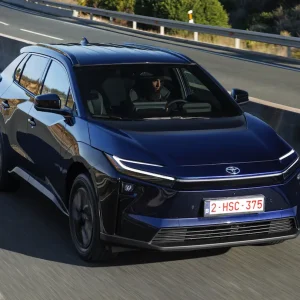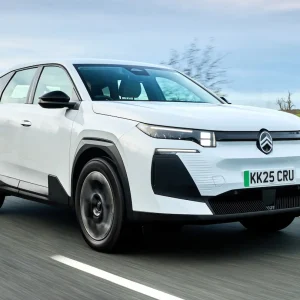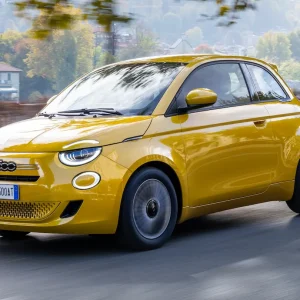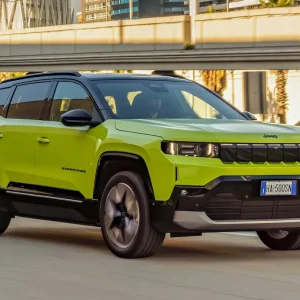If you want an attention-grabbing electric fleet, the new Honda E (the company’s first mass-market EV) looks like a great place to turn. Honda’s designers have created something that looks like nothing else on the roads today, with the retro simplicity of its exterior lines blended with LED lights, flush door handles, and an absence of door mirrors (of which more later). While the fleet electrification debate is rightly dominated by facts and figures, the E’s aesthetic appeal is bound to help with driver buy-in.
Arguably, the car’s interior is even more impressive. Multiple in-car screens are routine these days, but it’s still striking to find five displays in a row lining the dashboard. These include a digital instrument display, and a pair of infotainment touchscreens – the one on the left is meant for a front seat passenger, and solo drivers can control everything from the right-hand screen. Although the displays might look imposing at first, once you’re driving they’re no more distracting than any other modern car dashboard, and despite the tech-showcase feel there are still physical ventilation controls, which is very welcome.
Then there are the two outer screens, which show pictures from the rear-view cameras that substitute for regular door mirrors. Style points aside, Honda says losing the mirrors reduces drag and wind noise, and improves visibility in rain or at night, something we couldn’t validate on our sunny daytime drive. What we can tell you however is that when you’re used to driving cars with conventional wing mirrors, it’s difficult to judge with a glance at the screens how far away other vehicles are. Also, hold the wheel at a ten-to-two position and your right hand partially obscures the driver’s side display. There are problems too with the central mirror, also replaced (with Advance spec) with a camera display, as in sunlight reflections from the car’s interior obscure what’s behind, though at least in this case you can toggle back to a conventional mirror view.
Mirrors aside there’s a lot to like about the E’s interior – like the outside it’s an appealing mix of modern and retro, with the screens amid wood and fabric that feel more like a car from the 1980s, but not in a unappealing way. For the car’s size there’s a great sense of interior light and space – from the front seats anyway. Rear space is OK for a town car but no more than that, and at just 171 litres the boot isn’t fit for much more than urban runaround duties.
It shows how normalised EVs are becoming that we’ve got this far without mentioning the powertrain. Two motors are available – a 136hp version or the 154hp unit tested here. That’s a good deal of propulsion for a small car like this, and it’s just one reason why driving the E is a real treat. Lots of small cars are claimed to offer ‘go-kart handling’, but with a rear-wheel drive layout, low centre of gravity and quick steering (and a turning circle of just 8.6m) the E gets closer than most. It’s a joy to whizz around the urban environment in, with the instant electric power delivery making it feel even quicker than the numbers suggest, and the flatness of its cornering makes even stringing together business park roundabouts a hoot. It’s not just a city slicker either – the motor keeps on shoving up to motorway speeds, and it feels just as comfortable overtaking HGVs here as it does around town.
So it looks fantastic and it’s great to drive – any other problems? The obvious flaw is range – only 137 miles as standard, and reduced to just 131 with the optional 17in alloy wheels. Which looks a problem when the likes of the Hyundai Kona Electric are around the 300-mile mark. But Honda says it’s enough for what city-based drivers need, and in fairness it’s far from alone in this argument, with the likes of the new Mini Electric and VW E-Up also offering ranges in the mid-100s. If you’re electrifying your fleet, you should be able to decide for yourself how big an issue this is, based on your usage requirements – but it’s unarguable that cars like the E will offer less flexibility than alternatives with bigger batteries.
The other question is price. Including the government’s £3,000 plug-in car grant, the E range starts at just over £26,000, and it’s £2,500 more for the top-spec Advance tested here. That looks expensive for such a small car, but considering its rivals it doesn’t seem out of order. It’s a similar price to the similarly stylish and short-range Mini, and the Renault Zoe, which will go a lot further on a charge but is far more conservative-looking. The VW is much cheaper, but should be given the basic design is nearly a decade old, and the long-range Kona is far more expensive.
Honda clearly hopes fleets will see the E as more than a fashion accessory, since it’s expecting them to take a 40% share of sales. Whether it’s proved right could come down to how many find the limited range prohibitive, and how many feel the model’s image and panache are worth paying for.
Honda E 154 Advance (17in Alloys)
P11D: £32,105
Residual value: 39.3%
Depreciation: £19.480
Fuel: £2,477
Service, maintenance & repair: £1,462
Cost-per-mile: 38.99p
Range: 131 miles
CO2 (BIK Band): 0g/km (0%)
BIK 20/40% per month: £0/£0
Boot space: 171 litres
Engine size/power: 154hp electric motor





